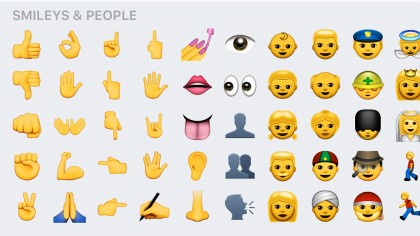How the rise of emoji has left the world lost for words
Pictures that tell a thousand words

Emoji has changed the way the world communicates. You can now order a slice of pizza, request room service or even show support for politicians with emoji. Sony is even mid-way through developing an animated movie based on those little characters you find in your phone.
Emoji is now so much part of our culture, the Oxford University Press declared the 'Face with Tears of Joy' emoji is the "word of the year".
You might laugh at this news, there may even be tears, but Vyv Evans, Professor of Linguistics at Bangor University, believes emoji has enhanced the way we communicate with each other.

"[The Word of the Year award] challenges people's perceptions of language and what a word actually is. The reason is that it's so prevalent, emoji is the current form of communication," says Evans.
"Over 6 billion emoji were sent everyday last year. I think in some way it's quite apt that an emoji has been selected."
6 billion emoji sent on a planet that houses 7 billion people.
Picture perfect
No one could have predicted the rise of emoji, something that was invented in 1999 in Japan where around 180 characters were initially created. The translation of emoji roughly means 'picture'.
Sign up for breaking news, reviews, opinion, top tech deals, and more.
The Western world didn't see the adoption of official emoji until 2010 when Unicode, an organisation that coordinates the development of messaging platforms, adopted them as the norm.
Since then emoji has been included in a number of platforms including iOS and Android. It has been likened to Hieroglyphics since it launched, but the concept is quite different.
"Strictly speaking emoji is not a language. It's a form of communication. It's adding an element that's missing from text-based communication," explains Evans.

"Emoji is best likened to the social cues that we get when we communicate in spoken language. Those are non-linguistic.
"Most people think that meaning comes from words and the grammatical rules that we use to combine words into sentences – in fact, it's only part of the meaning we get from face-to-face encounters."
Emoji have developed past their original purpose. It's not all just about giving a friend a wink on a sarcastic message anymore.
"Works of literature have even been translated into emoji," notes Evans.
"Alice in Wonderland, a book of 27,500 thousand words, has been translated into around 25,000 emoji. It is possible for emoji itself to become a visual language. But that's not how many people use it, most use it to punctuate digital expression.
"What was a relatively simple idea to put emotion back into text speak has now jumped the species divide and is being used all over the place."
Lost in translation
Emoji has been adopted the world over meaning you can communicate with the same icons to someone on the other side of the planet. Sending little photos can make communication across languages much easier - but there are cultural differences to be careful of, Evans explains.

"A smile means the same thing more or less whether you speak English, French, Japanese or Swahili. However, there are cultural differences in how emoji are used The praying hands emoji in Western culture relates to represents religious seminary.
"But that's not the origin of the emoji. It's from Japanese culture where it relates to a conventional sign that people make to say please and to thank somebody."
Cultural differences are not the only issue within emoji communication. Each platform has a slightly different version of emoji that means sending one to a different device can sometimes end in a mistranslation.
For example, if you send an emoji of the smiley poo on iOS 9.1 to a device running Android 5.0 Lollipop it'll come out the other side as a poo with flies and no face.
The same with dancing figures, on iOS it's a lady but viewed on a Samsung or Microsoft device it comes out the other end as a man. If you're using Google's keyboard it's a gender neutral animal creature instead.
It can change the meaning of the emoji from what the sender originally intended.
"This kind of thing is not supposed to happen because Unicode sets criteria for how things should be displayed in terms of how central they should be, what features they should have. But there is a difference across all the platforms," says Evans

And then there's the 'alien in the box' phenomenon. If you don't have a supported emoji on your platform, it can appear as an alien in a box and confuses many within conversations as they think it's an emoji they don't have.
"Some people think this is some weird and wonderful emoji that they don't have. In fact, it's simply the designated way of signifying your device does support that particular emoji," says Evans.
Whether you love or hate them, emoji are here to stay and their affect on language is certain to grow even further. The Unicode shortlist for the 2016 update is already out and we could see the introduction of a ROFL emoji, lying face, selfie, avocado, mother Christmas and even more.
But if you don't think emoji is worthy of the word of the year award yet, don't worry. Evans believes "We won't see emoji appear in the Oxford English Dictionary anytime soon".
¯\_(ツ)_/¯

James is the Editor-in-Chief at Android Police. Previously, he was Senior Phones Editor for TechRadar, and he has covered smartphones and the mobile space for the best part of a decade bringing you news on all the big announcements from top manufacturers making mobile phones and other portable gadgets. James is often testing out and reviewing the latest and greatest mobile phones, smartwatches, tablets, virtual reality headsets, fitness trackers and more. He once fell over.